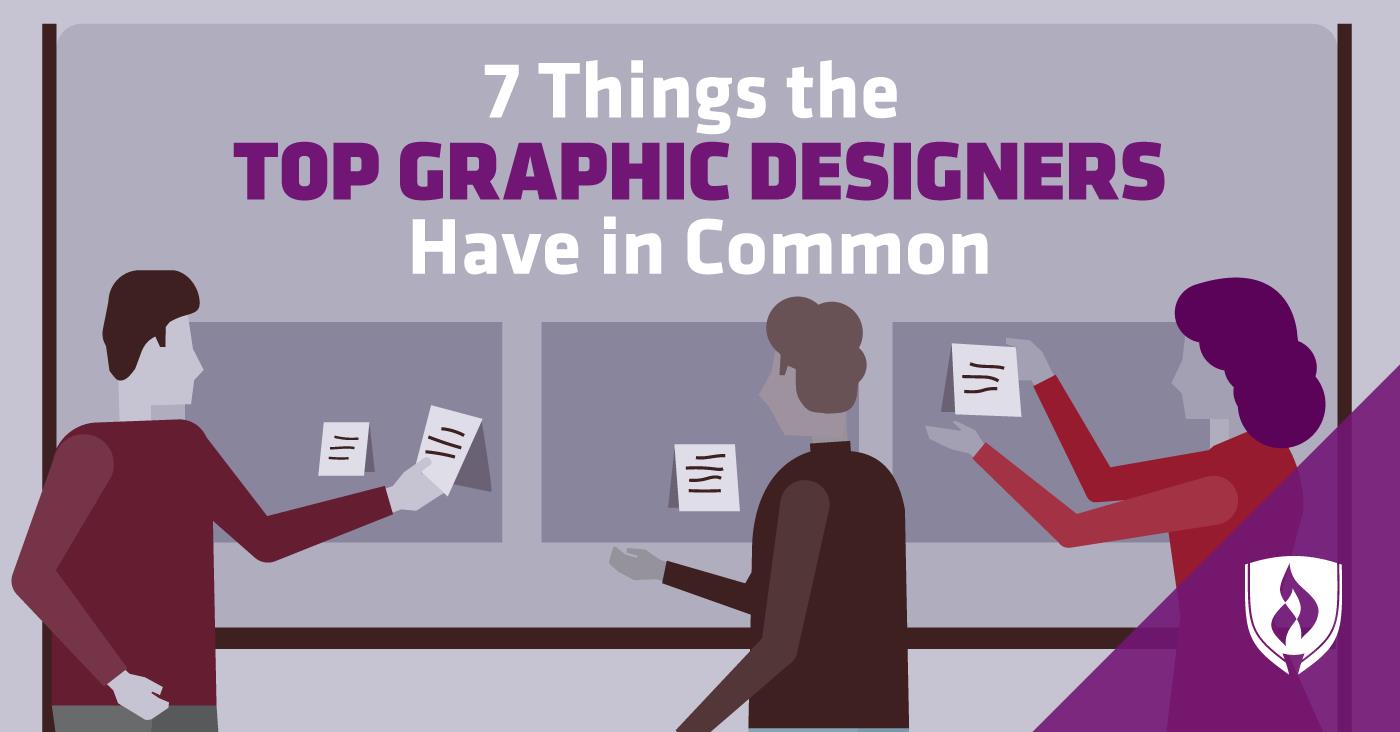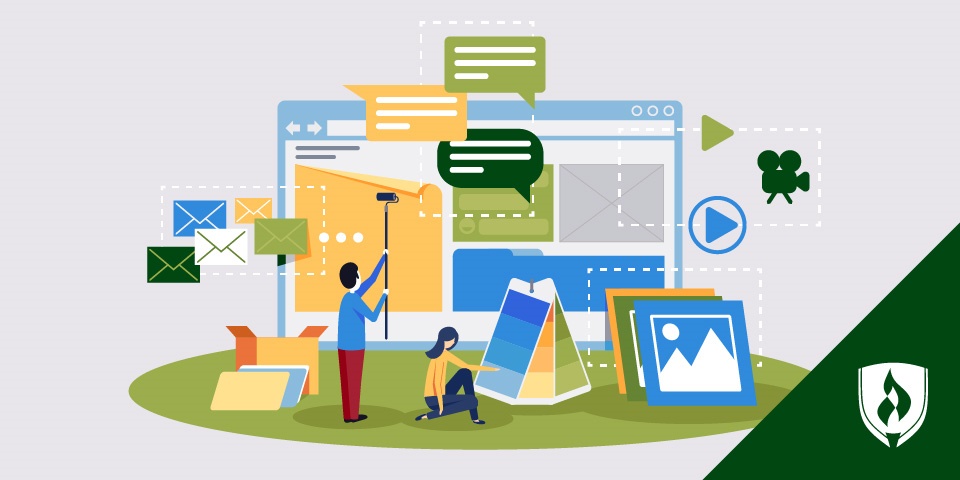
As with many career paths that bend more toward the artistic, graphic design can be considered somewhat unconventional in that there are multiple ways to land a job in this sector. Some design professionals are self-taught, while others are armed with a knowledge and instruction that comes with a Graphic Design degree. Others still may have a degree in a different field while having received some sort of technical training in design
The Bureau of Labor Statistics (BLS) maintains that in addition to boasting important qualities like artistic ability, creativity, computer skills and proficiency in communication, successful job candidates for graphic design positions are those who have sought out coursework in topics like writing, marketing and business. The BLS also urges design hopefuls to stay up to date with new and updated graphics and design software.*
But when an entire pool of job candidates is well qualified with all the skills one might find listed in a typical graphic design job description, which designers will stand out from the pack? We canvassed a handful of seasoned professionals to take us beyond the basic skill set of an up-and-coming designer and identify some of the must-have abilities the most successful graphic designers have mastered.
7 Qualities the best graphic designers share
All graphic designers are not the same. But there are some key characteristics that many great designers share. Keep reading to see if you have any of these inherent qualities that lend themselves well to this creative career.
1. They’re able to balance creativity & discipline
Josh Rubin, owner of Post Modern Marketing, has spent ample time training the many graphic designers he has employed. As he puts it, the words, “This is what separates the best designers from the rest,” come out of his mouth frequently.
When asked about the traits he sees most often in his best designers, discipline jumps to the top of his list. “Designers are often artists first, which means they are much more affected by [things like] whim and ‘artist’s block,’” Rubin explains. “But if you’re going to be a killer graphic designer, you have to fight through it. Good habits like always being on time, meeting deadlines, doing mundane tasks and organization are some of the most important to learn.”
He maintains that the best professional designers have learned how to keep to the schedule and fight through their lack of inspiration. Consistency, Rubin says, will earn you more respect than an out-of-this-world design that is submitted two weeks late.
2. They offer up-to-date, versatile portfolios
Sophie Miles is the vice president of human resources and cofounder of CalculatorBuddy.com, a European tech company that has since expanded to the U.S., Canada and South Africa. Having employed several graphic designers over the years, Miles has learned ways to detect quality designers as early as the interview and hiring phase.
It is not uncommon, she says, for designers to present portfolios that boast excellent work, but all the examples are at least five years old. Miles explains that she wants to see a candidate’s best work, but also their recent work. “I love seeing the progress in the pieces and how the style has changed over the years,” she iterates.
Miles is also partial to seeing portfolios that present a wide variety of work examples. She believes that while some may lean toward only showing work done for reputable brands, having worked for important companies doesn’t always give you the competitive advantage you may be seeking. She’s drawn to portfolios that include a mixture of top-tier brand work as well as personal or independent projects, as the variety not only shows a candidate’s full range of skills, but also their true dedication to their craft.
3. They are always eager to improve
Inquisitiveness and openness are two of the key characteristics of top designers, according to Trevor Wolfe, founder and CEO of BigTeam, who has worked alongside design professionals in the agency world for most of his career.
“Inquisitiveness means that the designer is not just curious, but intentionally seeking out new ideas, inventions and insights they can incorporate into their work,” he explains. “A designer not demonstrating a willingness to learn is a designer who could plateau.”
Wolfe says that openness is often demonstrated by a designer’s willingness and desire to hear feedback and outside opinions on their work. “[This] means that their work can be built upon and strengthened,” he adds.
4. They handle criticism well
In making themselves receptive to feedback, graphic designers inevitably have to open themselves up to accepting criticism. “The life of an artist in a corporate environment is tough,” Rubin admits. “You might present a design to your team or a client and get nothing but negative comments.”
Because design is very subjective, he explains, the best graphic designers have learned that their vision for a piece may not always suit the project best, but that doesn’t mean they’re unskilled artists. “If you get caught up in your own head after taking negative feedback, you won’t be able to succeed,” Rubin urges.
5. They’re detail-oriented
Another aspect Rubin has identified as being a critical element in a graphic designer’s toolbox is being detail-oriented. “The best designers sweat the small stuff,” he puts simply, offering the following example: If you have inconsistent spacing between sections on a website, the average viewer may not notice, but you better believe your art director and fellow designers will.
“Things like following brand guidelines, keeping consistent typography and catching spelling mistakes are more important to your boss than the exact balance of color composition you create,” Rubin says.
6. They think about the end goal
Judy Cutler is the art director for JessPerna.com, and her design career has led her to ask every client the same question at the very beginning of a new project: “What do you want the potential customer to think and feel when they see your ad?”
When artists get too entrenched in the design aspects of a piece without also considering the end goal as it relates to the customer experience, a campaign can often miss the mark. “You must be able to place yourself in the customer’s shoes to make a good ad or a great ad campaign,” she explains. “This question makes them ponder instead of jumping into a wild idea that makes no sense.”
7. They learn to master the business side of design
James Stefurak, founder and editor of The Invoice Factoring Guide, works with a number of freelancers, many of whom are graphic designers. “They are very independent people by nature,” he says. “Also, extremely creative, curious and bright. But they’ll be the first to admit they can mishandle the ‘business’ aspect of their work.”
Stefurak contends that it’s actually pretty common for graphic designers to undervalue their work. Whether it’s when negotiating numbers for a salaried position or discussing your rates as a freelancer, he believes that “Most graphic designers are worth way more money than they bill clients for.” It’s also common for artistic professionals of this nature to inherently take a backseat when it comes time to collect on unpaid invoices. If designers don’t learn to master the business aspects of their design careers, they may be taken advantage of.
Do you have what it takes to succeed in graphic design?
Even with all the formal training in the world, professional design hopefuls from every background can benefit from learning which qualities experienced business leaders have identified as essential for success in graphic design. As you continue to journey toward achieving your career goals, be sure to heed all the expert advice you can find along the way.
For more insight into life as a professional designer, head over to our article, “What I Wish Someone Told Me BEFORE Becoming a Graphic Designer.”
*Bureau of Labor Statistics, U.S. Department of Labor, Occupational Outlook Handbook, [career information accessed July 24, 2018] www.bls.gov/ooh/.




